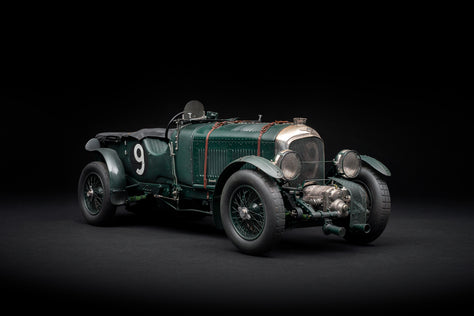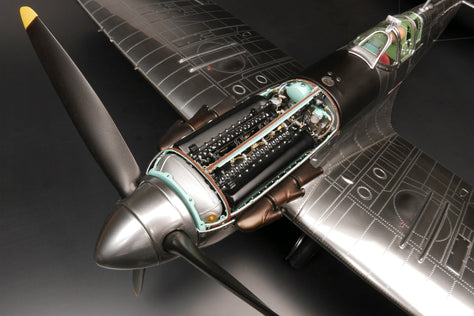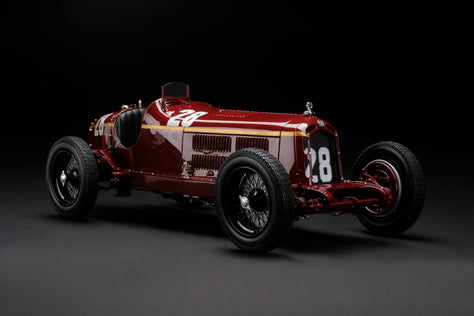Technical Details
- Description
- Scale guide
The aircraft that dropped more bombs than any other during World War II, the Boeing B-17 “Flying Fortress” quickly became the symbol of American air power during the conflict. Flying missions in every combat zone during the course of the war, the B-17 saw its most significant service in Europe, forming the backbone of the USAAF strategic bombing force alongside the Consolidated B-24 Liberator, and playing a crucial role in crippling Germany’s war industry. Legendary for its ability to take punishment and return with its crew, the “Flying Fortress” more than earned its moniker in the heat of battle.
The B-17’s design emphasised high altitude flight, speed, and heavy defensive armament. Four advanced turbo-supercharged radial engines allowed it to fly up to about 30,000 feet with a combat load, while powered turrets and flexible guns covered all areas around the aircraft to provide protection against attacking fighters. Bombing accuracy was to be achieved with the Norden bombsight, developed and fielded in great secrecy during the 1930s. In the hands of a skilled bombardier, the Norden was a remarkably accurate sight.
The B-17 design took form as the Boeing Model 299 prototype and first flew in 1935. Richard Williams, reporter for The Seattle Times, coined the now eternal name "Flying Fortress" when observing the large number of machine guns sticking out from the new airplane before its first test flight, describing the machine as a "15-ton flying fortress" in a picture caption. Seeing this, Boeing quickly trademarked it for use.
Boeing initially lost out on the Air Corps contract for which the B-17 was developed. Whilst Model 299 was clearly superior to its twin-engine rivals, the Douglas DB-1 and the Martin Model 146, at the USAAC ‘fly-off’ competition, it crashed. Command pilot Major Ployer Peter Hill and Boeing’s Chief Test Pilot Leslie R. Tower both succumbed to their injuries sustained in the accident, and Model 299 was disqualified, unable to complete the competition. The Air Corp were also nervous about the cost, as it was almost twice the cost of the option from Douglas. Regardless, the USAAC had been impressed by the prototype's performance, and in early 1936 ordered 13 YB-17s through a legal loophole.
Only a relatively small number of B-17s were in service when the US entered the war in 1941. Production rapidly increased, and three companies, Boeing in Seattle, Washington, Douglas Aircraft Co. in Long Beach, California, and Lockheed Vega Aircraft Corp. in Burbank, California, began mass-producing Flying Fortresses by the thousands.
Designed to attack strategic targets by precision daylight bombing, penetrating deep into enemy territory by flying above the effective range of antiaircraft artillery, the B-17 was continuously refined and improved based on lessons learned in battle over the ensuing years through many different variants and sub-variants, each featuring differing arrays of armament, engines and payloads. The B-17F was the fastest model and the primary heavy bomber early in the strategic bombing campaign. Development eventually culminated in the definitive B-17G, which entered service in the summer of 1943, equipped with a nose turret for better frontal defence, and it was also the most numerous, representing about two thirds of all B-17s made. Each aircraft was operated by a crew of 10, including the pilot, co-pilot, navigator-radioman, bombardier, and gunners. Production of the B-17 ended in May 1945 totalling 12,731 units, making it the third-most produced bomber of all-time.
Despite their outstanding firepower, formations of B-17s proved unable to fight their way unescorted to targets deep inside Germany without incurring excessive losses from enemy fighters. Long-range raids to target German industry were called off in mid-October 1943 and were not resumed until February 1944, when long-range escort fighters such as the P-51 Mustang became available. A 4,000-pound (1,800-kg) bomb load was typical for long missions, though the B-17 could carry up to 8,000 pounds (3,600 kg) internally for shorter distances at lower altitudes and even more on external racks beneath the wings. These increased bomb loads were used to good effect in attacks on the German aircraft and oil industries before the Normandy Invasion of June 1944 and in “carpet-bombing” raids supporting the Allied breakout into Brittany and northern France later that summer. Of the roughly 1.5 million tons of bombs dropped on Germany and its occupied territories by USAAF aircraft, over 640,000 tons (42.6%) were dropped from B-17s.
Rendered obsolete by the larger, more powerful and more advanced B-29 Superfortress, the B-17 was quickly phased out after the ending of World War II, though some examples served on after the war in second-line roles such as VIP transports, air-sea rescue and photo reconnaissance. A few others continued in various civil roles, particularly as fire bombers, in the post-war years. Overall, the B-17 had excellent flight characteristics and, unlike the B-24, was almost universally well regarded by those who flew it, much preferred for its greater stability and ease in formation flying. Its electrical systems were also less vulnerable to damage than the B-24's hydraulics, and the B-17 was considered easier to fly than a B-24 when missing an engine.
This fine scale model will be based upon the famed B-17F Flying Fortress “Memphis Belle”, one of the first USAAF B-17 heavy bombers to complete 25 combat missions, and the first to return to the United States. The ten-strong crew at times featured: pilot Captain Robert K. Morgan; co-pilot Captain James A. Verinis; navigator Captain Charles B. Leighton; bombardier Captain Vincent B. Evans; crew chief Joe Giambrone; radio operator Robert Hanson; engineers and gunners Gunner Leviticus "Levy" Dillon, Eugene Adkins, Harold P. Loch; gunners Cecil Scott, E. Scott Miller, Casmer A "Tony" Nastal, Clarence E. "Bill" Winchell and John P. Quinlan; and mascot Stuka the Scottish Terrier, belonging to Verinis. The Memphis Belle was named after Morgan’s sweetheart back in Memphis, Tennessee, after Morgan and Verinis had watched the film Lady for a Night, in which the leading character owns a riverboat named the Memphis Belle. After proposing the name, the crew voted and swiftly adopted the new moniker. Morgan then contacted George Petty at the offices of Esquire magazine and asked him for a pinup drawing to go with the name which, once Petty had supplied imagery from the magazine's April 1941 issue, was transferred to both sides of the forward fuselage by the 91st Bomb Group artist, Corporal Tony Starcer. The Belle was depicted in her swimsuit in blue on the aircraft's port side and in red on the starboard side. Later, the nose art later included 25 bomb shapes, one for each mission credit, and eight Nazi swastikas, one for each German aircraft claimed shot down by the crew. Station and crew names were stencilled below station windows on the bomber after its tour of duty was completed.
The Belle was at first briefly deployed to Prestwick, Scotland, in September 1942 before moving to its operational base in Bassingbourn, England, in October 1942. The 25 missions completed by the crew were all flown between the 7th of November 1942 and the 17th of May 1943 and were centred in France, though sorties were flown over the Netherlands and Germany, whilst the Belle was also flown by a different crew on five other occasions during this period. The Memphis Belle was flown back to the United States on the 8th of June 1943 by a composite crew chosen by the Eighth Air Force, which Morgan then led on a 31-city war bond tour. Morgan's original co-pilot Verinis was promoted to Aircraft Commander of another B-17 for his final sixteen missions but finished his own tour on the 13th of May, re-joining Morgan's crew as co-pilot for the flight back to the United States. Following its tour of the United States, Memphis Belle was assigned to MacDill Field, Florida, where it became a training aircraft until Victory in Europe Day, after which it travelled to Altus AAF, Oklahoma, for storage and eventual reclamation.
After the war, it was claimed by the city of Memphis and displayed at the city’s National Guard armoury. Sat outdoors for years, the Belle’s once proud frame deteriorated due to weather and vandalism. In the 1970s, custody was returned to the USAAF and the Belle moved to Mud Island in the Mississippi river for continued display. The aircraft was disassembled for restoration in 2003, and eventually, in 2005, moved to its current location at the National Air Museum of the United States Air Force at Wright-Patterson Air Force Base near Dayton Ohio. Following years of meticulous restoration, a reconditioned Memphis Belle was revealed on the 17th of May 2018, 75 years to the day of its twenty-fifth combat mission. The Belle now resides in the museum’s World War II gallery.
The B-17F Flying Fortress ‘Memphis Belle’ is limited to just ten pieces at 1:32 scale.
Please note that, due to the large size of this piece and complexities of shipping, additional costs will be calculated and billed separately based on delivery location.
Pre-order
Bespoke
In order for us to create your bespoke model, you will need to choose 4 extra options. Paint colour, interior colour, wheel style and caliper colour.
Please complete the form and a member of our Sales Team will contact you.
Contact Us
Please contact us for more information about ordering this model.







